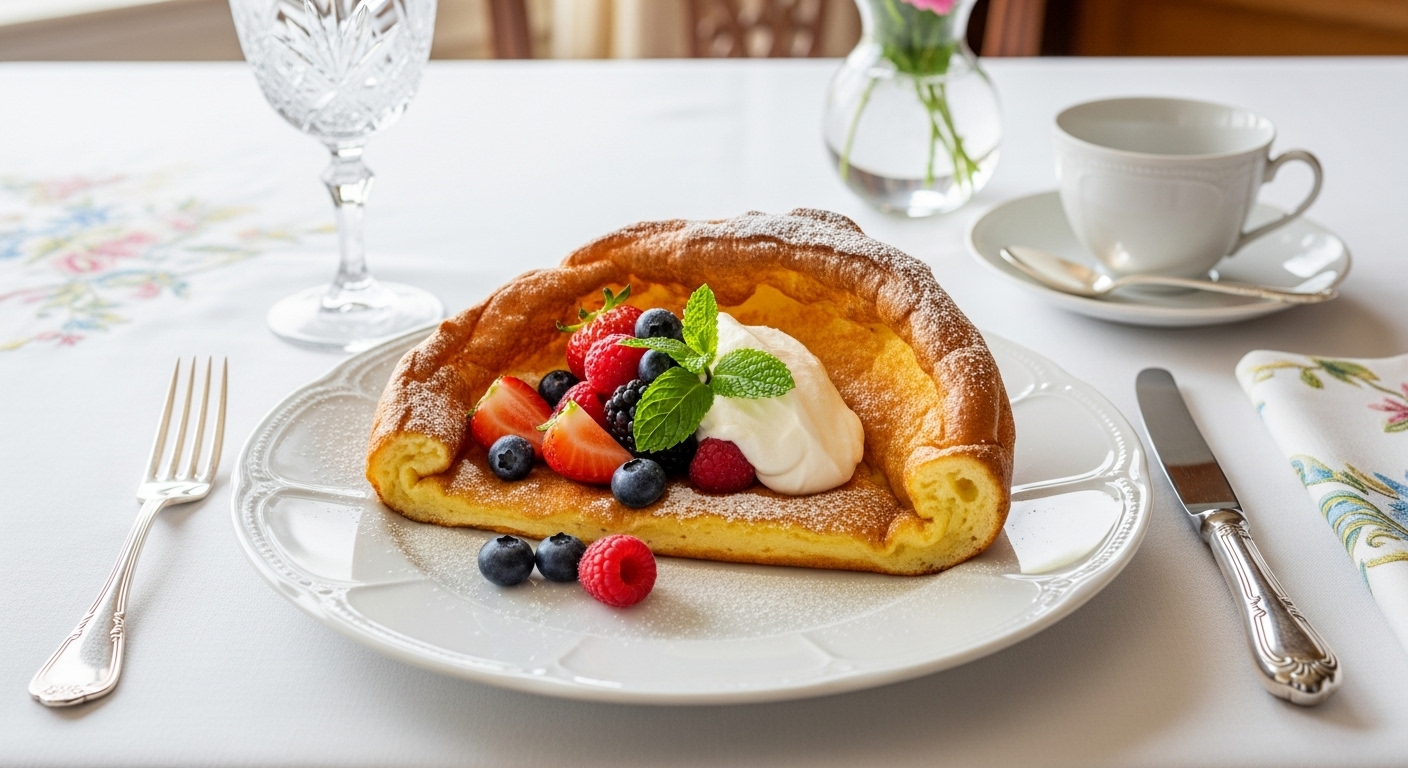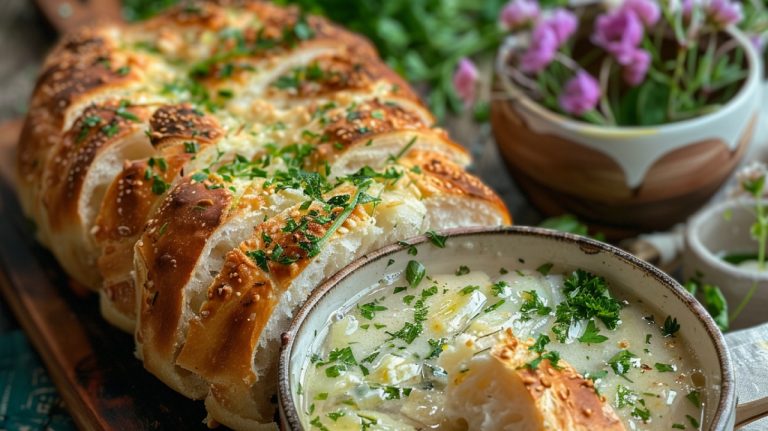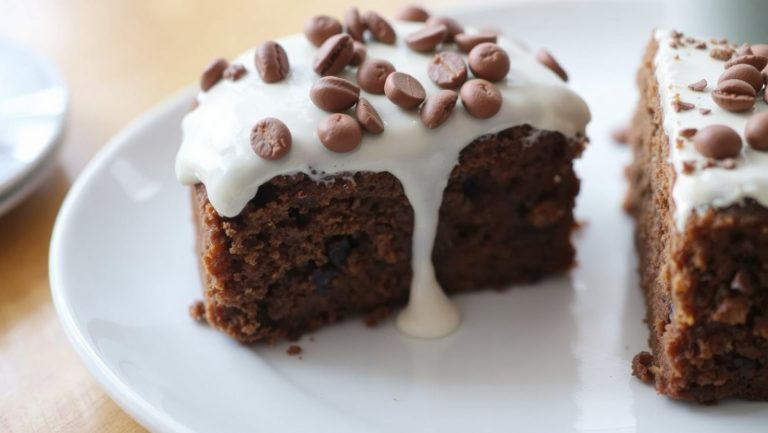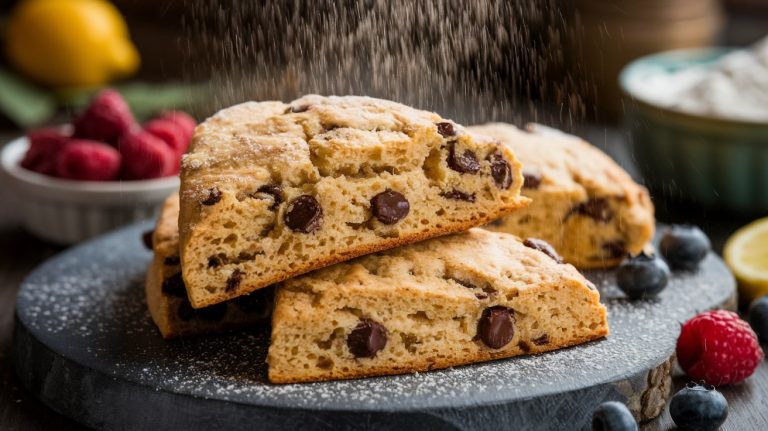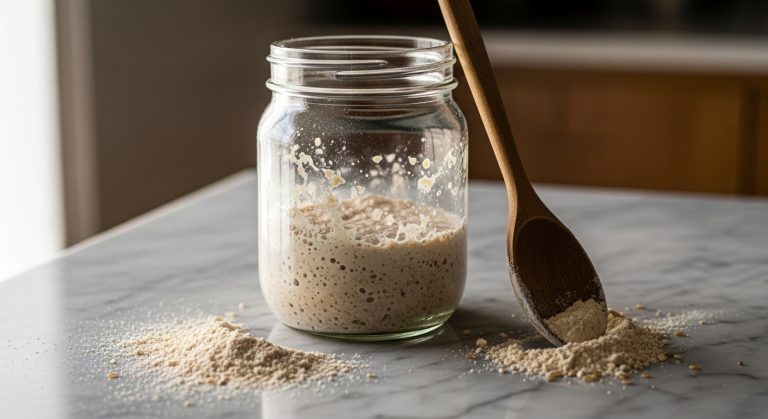Sourdough Discard Dutch Baby Recipe: Simple Morning Magic
You can turn your sourdough discard into a delicious Dutch baby pancake with just a few ingredients: eggs, milk, butter, and a pinch of salt.
Blend everything smooth, fold in whipped egg whites for fluffiness, and bake in a hot, buttered skillet at 425°F until puffed and golden.
Serve it with sweet or savory toppings for a satisfying meal. Keep exploring to discover tips for perfect rise, flavor twists, and smart storage ideas.
Key Takeaways
- Combine sourdough discard, eggs, milk, melted butter, and salt; fold in whipped egg whites for an airy Dutch baby batter.
- Preheat a cast iron skillet to 425°F, coat with butter, pour batter, and bake 15-20 minutes until puffed and golden.
- Serve immediately with sweet toppings like berries and powdered sugar or savory options like smoked salmon and herbs.
- Use room-temperature ingredients, avoid opening the oven early, and rest batter 10 minutes for best rise and texture.
- Store leftovers refrigerated up to 2 days; reheat gently to maintain crispness, or freeze for later use.
Complete Sourdough Discard Dutch Baby Recipe
| Component | Ingredient | Amount | Notes |
|---|---|---|---|
| Base | Sourdough discard | ¾ to 2 cups | Room temperature for best mixing |
| Protein | Large eggs | 4-6 whole eggs | Room temperature, separate whites |
| Liquid | Whole milk | 6 tbsp to 1 cup | Room temperature preferred |
| Fat | Butter | 4-6 tbsp melted + 2 tbsp for pan | High-quality for best flavor |
| Seasoning | Salt | ½ teaspoon | Balances tangy sourdough flavor |
| Optional | Vanilla extract | 1 tsp | Enhances overall taste profile |
| Optional | Sugar/maple syrup | 1-2 tbsp | Sweetness to preference |
| Step | Instructions | Time | Key Tips |
|---|---|---|---|
| Prep | Preheat oven to 425°F with skillet inside | 15 min | Cast iron works best |
| Mix | Blend discard, milk, egg yolks, butter, salt | 30 sec | Smooth consistency is crucial |
| Whip | Beat egg whites to stiff peaks | 2-3 min | Don’t overbeat |
| Fold | Gently combine mixtures with spatula | 1 min | Preserve airiness |
| Bake | Pour into hot buttered skillet, bake | 15-20 min | Don’t open oven door |
| Serve | Immediately with desired toppings | – | Puff deflates quickly |
Ingredients Needed for the Dutch Baby
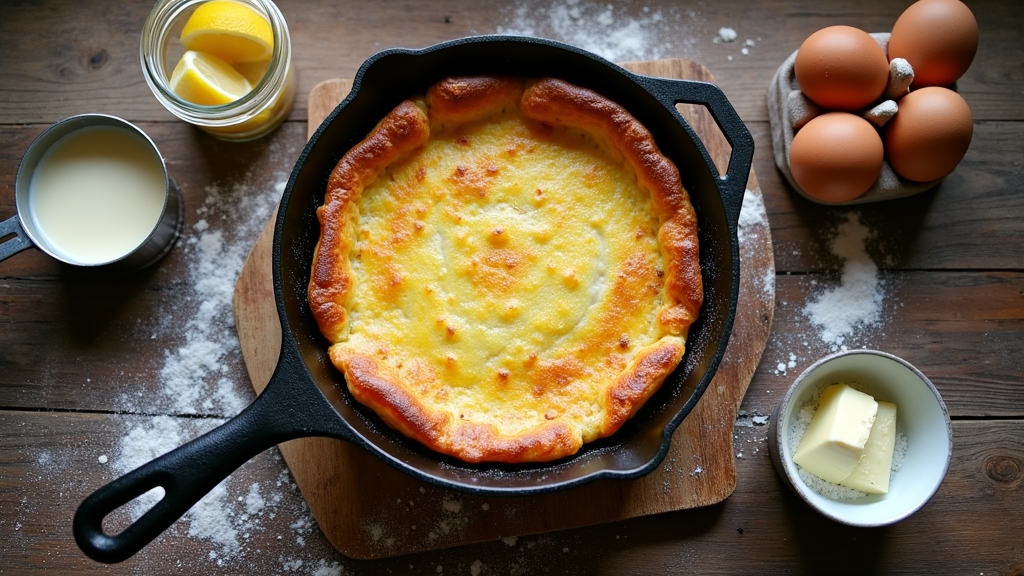
To make a perfect sourdough discard Dutch baby, you’ll need a handful of key ingredients that work together to create its signature rise, flavor, and texture.
Start with ¾ to 2 cups of room-temperature sourdough starter discard, which acts as your natural leavening and adds depth. Using precise measurements with a digital baking scale can help ensure consistent results every time.
Begin with ¾ to 2 cups of room-temperature sourdough discard for natural rise and rich flavor.
Add 4 to 6 large eggs, also at room temperature, to build structure and richness.
Pour in 6 tablespoons to 1 cup of milk, preferably whole, for tenderness and moisture. Letting the milk, sourdough, and eggs sit out for about 30 minutes before mixing can improve the batter’s puffiness by ensuring room-temperature ingredients.
Butter plays a dual role: 4 to 6 tablespoons melted in the batter and more for greasing the pan, enhancing flavor and browning.
A pinch of salt, about ½ teaspoon, balances the flavors.
Optional touches like vanilla extract or cinnamon can elevate the taste, while sweeteners like maple syrup are up to you.
Essential Equipment and Preparation Tips
Although gathering the right equipment might seem straightforward, having the proper tools can make all the difference in achieving that perfect puff and golden crust for your sourdough discard Dutch baby.
Opt for a 10-12 inch cast iron or heavy-bottomed oven-safe skillet to ensure even heat retention and browning. Using a cold pan initially and then placing it in a hot oven helps the Dutch baby puff up dramatically during baking.
Preheat the skillet in a 425°F oven, then melt butter inside to create a crispy, nonstick base.
Use a blender or electric mixer to blend batter smoothly, but fold in whisked egg whites gently with a silicone spatula to preserve airiness.
Keep ingredients at room temperature for better mixing.
An oven thermometer helps maintain precise heat, while oven mitts protect your hands when handling the hot skillet.
These simple prep tips set you up for Dutch baby success.
Mixing the Batter for Optimal Rise
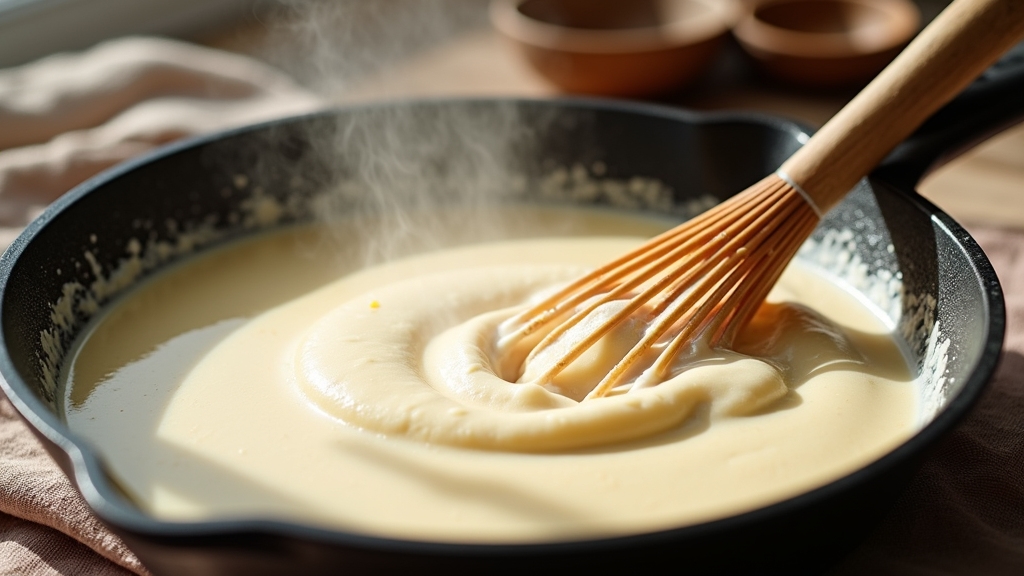
When you mix the batter for your sourdough discard Dutch baby, achieving the right balance and texture is key to a spectacular rise.
Start by blending the sourdough discard, milk, egg yolks, melted butter, salt, and optional sugar or vanilla until smooth. Use a blender or hand mixer for about 30 seconds. The batter should be thinner than pancake batter but thicker than crepe batter. Using room-temperature ingredients helps ensure even mixing and proper fermentation.
Next, beat egg whites separately to stiff peaks. This step is essential because the whipped egg whites act as natural leaveners that give the Dutch baby its dramatic puffiness.
Then gently fold them into the batter with a silicone spatula to preserve airiness.
Use room-temperature ingredients and let the batter rest for 10 minutes to hydrate and relax gluten.
This careful mixing and resting create the light, puffy texture that defines a perfect Dutch baby.
Baking Instructions and Timing
Hey there! So, first things first, you’ll want to preheat your oven to somewhere between 425°F and 465°F. While that’s heating up, pop your cast iron skillet inside to get it nice and scorching hot.
This step is super important because it helps create that perfect crust.
Now, let’s talk timing—this is where it gets a bit tricky! You’ll be baking your Dutch baby for about 15 to 20 minutes. Keep an eye on it until it puffs up and develops that beautiful golden brown crust.
Just a heads up, you might need to adjust the baking time a bit depending on the size of your skillet. You want to make sure the center is perfectly cooked while those edges get nice and crispy.
Preheat and Skillet Prep
A properly preheated oven and skillet lay the foundation for a perfectly risen sourdough Dutch baby.
Start by setting your oven to 425°F (218°C) and place the rack in the middle for even heat circulation.
Slide your 9-12 inch cast iron skillet into the oven as it warms, allowing it to reach a high temperature necessary for crisp edges and dramatic puffing.
Once hot, carefully remove the skillet and immediately add about 2 tablespoons of butter, swirling it to coat the bottom and sides evenly.
This hot butter layer prevents sticking, promotes browning, and supports steam formation essential for rise.
Quickly pour your batter into the sizzling skillet to preserve heat, ensuring that your Dutch baby begins its impressive puff right away.
Rest the batter for 10 minutes before beginning the baking process to improve texture and rise.
Baking Time and Temperature
Although baking times can vary, maintaining a temperature around 425°F (218°C) usually strikes the perfect balance between a dramatic puff and golden, crisp edges.
At this temperature, your sourdough Dutch baby typically bakes in 15 to 20 minutes, filling your kitchen with a tantalizing aroma. Using a digital baking thermometer can help you monitor the oven temperature precisely for best results.
To nail the timing and texture, keep these tips in mind:
- Use a preheated skillet and place it on the middle or lower third oven rack for even heat.
- Avoid opening the oven during baking to prevent deflation and uneven cooking. The Dutch baby puffs due to steam and rapid expansion of trapped air bubbles, so maintaining oven temperature is crucial.
- Adjust time based on skillet size; smaller pans need less time, larger ones may require 20+ minutes.
- Let your Dutch baby rest 5–10 minutes after baking to set and stabilize before serving.
Serving Suggestions and Topping Ideas
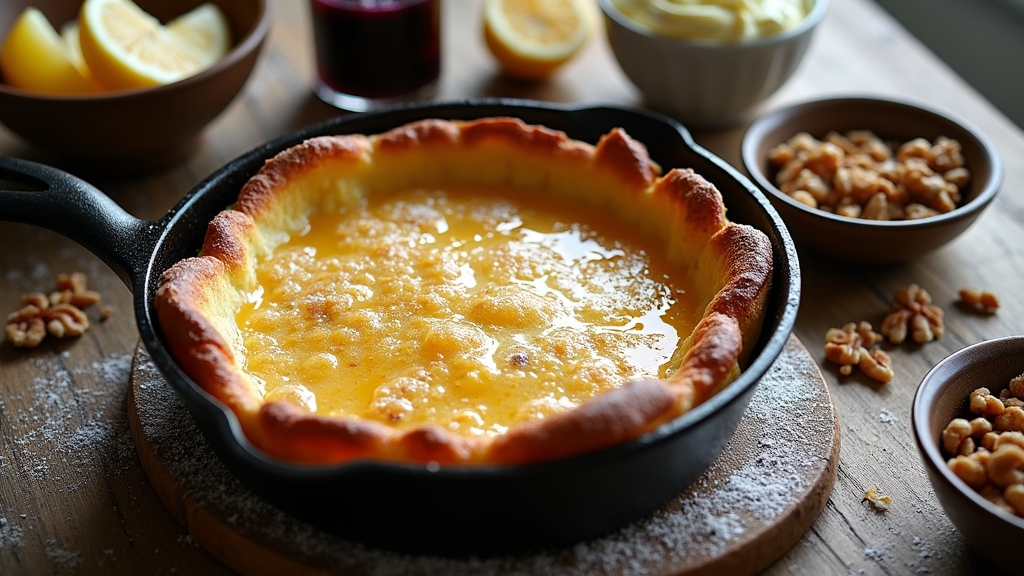
How can you transform a sourdough discard Dutch baby into a memorable dish? By choosing toppings that highlight its airy texture and tangy flavor.
Whether you crave sweet or savory, there’s a perfect pairing waiting for you. Fresh berries and powdered sugar add color and lightness, while smoked salmon and herbs bring sophistication.
Don’t forget texture—nuts and seeds create delightful crunch, and citrus zest brightens every bite.
The natural tanginess from the sourdough fermentation process enhances the flavor profile and can complement a wide variety of toppings.
| Sweet Delights | Savory Sensations | Textural Twists |
|---|---|---|
| Maple syrup drizzle | Savory breakfast sausage | Toasted pecans |
| Whipped cream dollop | Sautéed spinach | Shredded coconut |
| Fresh berries mix | Cream cheese spread | Pumpkin seeds |
| Lemon wedge squeeze | Grated Parmesan | Cinnamon sprinkle |
Mix and match these ideas to serve a Dutch baby that’s as beautiful as it is delicious.
Variations and Flavor Enhancements
When you experiment with variations and flavor enhancements, your sourdough discard Dutch baby can transform from a simple breakfast staple into a versatile culinary canvas.
You can tailor it to sweet or savory preferences, adjusting ingredients and textures to suit any occasion.
Consider these options to elevate your dish:
- Swap vanilla and cinnamon for herbs like thyme or smoked paprika to create a savory Dutch baby.
- Add cocoa powder or finely grated chocolate for a rich, chocolate-flavored twist.
- Incorporate chopped nuts or fruit purees such as pumpkin or apple to boost texture and natural sweetness.
- Substitute dairy milk with plant-based alternatives and replace butter with coconut oil for vegan or allergy-friendly versions.
These tweaks let you craft a Dutch baby that’s uniquely yours every time. Keep in mind that hydration levels and ingredient choices significantly impact the texture and flavor of your final dish.
Nutritional Benefits and Practical Tips
Using sourdough discard in your Dutch baby is a win-win! Not only does it help cut down on food waste, but it also creates a balanced meal packed with protein, carbs, and fats.
It’s pretty awesome how the mix of ingredients can support digestion and give you that lasting energy boost throughout your day. The natural fermentation process also enhances nutrient absorption and reduces digestive issues through prebiotic content. The recipe is quick to prepare, taking only about 10 minutes prep time before baking.
And hey, if you want your Dutch baby to be at its absolute best, make sure to serve it fresh. When you need to reheat it, just do it gently. That way, you’ll keep that perfect puff and crispness that makes it so delicious!
Waste Reduction Advantage
Although sourdough discard might seem like kitchen waste, it offers impressive nutritional benefits and practical advantages that you’ll want to take advantage of.
By incorporating discard into your recipes, you reduce food waste and support sustainable kitchen habits. Plus, it enhances your baking’s nutritional value with beneficial probiotics and easier-to-digest carbohydrates. Properly freezing and thawing sourdough discard can help preserve these benefits for later use by maintaining its resistant starch formation.
Here’s how using sourdough discard benefits you and the environment:
- Cuts down on wasted starter, turning what would be trash into tasty dishes.
- Lessens the need for extra flour and ingredients, lowering your kitchen’s environmental impact.
- Helps maintain a healthy gut by introducing natural lactic acid bacteria.
- Saves money by maximizing your home-baking resources and reducing ingredient costs.
Additionally, sourdough discard contains prebiotics that support digestion and gut health.
Embrace sourdough discard to bake smarter, healthier, and greener!
Balanced Macronutrient Profile
Embracing sourdough discard not only cuts waste but also brings a well-rounded nutritional boost to your meals. Your Dutch Baby packs 7-11 grams of complete protein from eggs and starter, fueling muscle repair and keeping you full longer.
Carbs, mainly from fermented flour, offer digestible energy with a moderate fiber punch that nurtures gut health and stabilizes blood sugar. Sourdough acts as a source of prebiotics, feeding good gut bacteria and enhancing digestion. The 10-12 grams of fat, including heart-friendly mono- and polyunsaturated fats, enhance flavor and help absorb vitamin A. Additionally, the fermentation process reduces phytic acid, improving mineral absorption in your digestive system.
Plus, fermentation boosts minerals like potassium, iron, and magnesium, supporting your cardiovascular and immune systems. When you whip up this dish, you enjoy balanced macronutrients that deliver steady energy and promote digestion, making it a smart, nourishing choice for any meal.
Serving and Storage Tips
When you serve your sourdough discard Dutch Baby right out of the oven, you’ll enjoy its signature puffiness and crispy edges at their peak. To make the most of this delicious dish, consider these tips:
- Customize flavors by pairing with fresh berries, maple syrup, or savory toppings like smoked salmon and herbs. Adding spices like cinnamon can also enhance the flavor profile and complement the natural tang of sourdough.
- Slice it into wedges for easy sharing, highlighting the contrast between the custardy center and crispy crust. The recipe’s use of eggs provide leavening means no chemical agents are needed, giving a natural rise and texture.
- Store leftovers in an airtight container in the fridge for up to 2 days, reheating gently in a skillet to keep crispiness. Avoid refrigeration for longer storage, as it can lead to staling and moisture loss.
- Freeze individual portions wrapped tightly, then thaw and reheat to preserve texture without losing puffiness.
These practical tips help you enjoy your Dutch Baby’s unique taste, texture, and nutritional benefits while reducing waste through cold fermentation techniques.
Frequently Asked Questions
Can I Use a Non-Cast Iron Skillet to Make a Dutch Baby?
Yes, you can use a non-cast iron skillet to make a Dutch baby.
Just make sure it’s oven-safe and preheat it thoroughly to mimic cast iron’s heat retention.
Use a smaller pan for a thicker, puffier result, and melt plenty of butter before pouring the batter.
Keep the oven door closed during baking to maintain puffiness.
While the rise might be slightly less dramatic, you’ll still get a delicious, impressive Dutch baby.
How Do I Store Leftover Dutch Baby for Later Use?
Back in the age of quills and parchment, you’d stash your Dutch baby in airtight containers or sealable bags to keep it fresh.
You should refrigerate leftovers for up to 3 days, though texture softens after a day or two.
For longer storage, freeze cooled pieces with parchment paper between them. Thaw overnight in the fridge and reheat gently in a skillet or oven to revive crisp edges without drying it out.
Is It Possible to Make This Recipe Gluten-Free?
Yes, you can definitely make this recipe gluten-free! Just swap traditional flour for gluten-free options like tapioca flour or a blend like King Arthur Measure for Measure.
Use a gluten-free sourdough starter, too, to avoid cross-contamination. Keep in mind, gluten-free batters behave differently; they might be denser and need moisture adjustments.
Resting the batter and tweaking baking times will help you get a tasty, satisfying Dutch baby without gluten.
Can I Prepare the Batter the Night Before Baking?
You can prepare the batter the night before, but you’ll need to refrigerate it to keep it safe.
Expect the flavor to get tangier and the texture to thicken. Before baking, whisk it well and thin it with a bit of milk if needed.
What Causes Dutch Baby to Deflate Quickly After Baking?
Your Dutch baby deflates quickly because it’s like a hot air balloon losing steam. The oven’s heat gives it a dramatic puff, but once out, it naturally collapses.
If your pan isn’t hot enough or you open the oven door too soon, the puff won’t hold.
Using cold ingredients or skipping batter rest weakens its structure.
Serve immediately and don’t add moist toppings too soon to keep your Dutch baby soaring longer.
Turn Food Waste into Your New Breakfast Favorite
Now that you’ve mastered this sourdough discard Dutch baby, you’re ready to impress with ease and flavor.
Remember, “waste not, want not.” Using your discard turns what might be thrown away into a delicious breakfast treat.
With simple ingredients and quick steps, you’ll enjoy a fluffy, golden pancake that’s perfect for any occasion.
Keep experimenting with toppings and flavors to make this recipe truly your own.

